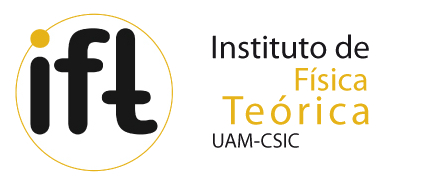Effective Field Theory for Quantum Many Body Systems, January 15.-17. 2014
Program
NOTE THE CHANGE in PROGRAM !!!!
|
|
Wednesday 15 | Thursday 16 | Friday 17 | |
|---|---|---|---|---|
| 10:00h Nicolis | ||||
| 10:30h | Hidaka | Wiese | 11:00h Coffee |
|
| 11:30h | Coffee | Coffee | 11:15h Shovkovy | |
| 12:00h | Penco | Hofmann |
12:15h Yamamoto |
|
| 13:00h | Lunch | Lunch | Lunch | |
| 15:00h | Piazza | Bedaque | ||
| 16:00h | Coffee | Coffee | Coffee | |
| 16:30h | Watanabe | Papenbrock |
PAULO BEDAQUE: Angulons in triplet condensed neutron matter
Neutron matter at densities above the nuclear density (as found in
neutron stars) is believed to be superfluid due to the pairing of neutrons in
the 3P2 channel. The pair, being a spin 2 object, breaks rotation symmetry when
it condenses and leads to the existence of Goldstone bosons, sometimes called
"angulons". After a quick introduction to the astrophysical motivations, we will
discuss the effective theory of angulons and survey the calculation of
"observables". We also discuss the change in the angulons mass in the presence
of large magnetic fields.
YOSHIMASA HIDAKA: Broken spacetime symmetries, elastic variables, and Nambu-Goldstone modes
We discuss spontaneous breaking of continuum symmetries, whose generators do and
do not depend on the spacetime coordinates. We clarify the relation between broken symmetries and
elastic variables at both zero and finite temperatures, and/or finite densities, and show the general
counting rule that is model-independently determined by the symmetry breaking pattern. We also
discuss the relation between elastic variables and Nambu-Goldstone modes, and their dispersions.
CHRISTOPH HOFMANN: Impact of the spin-wave interaction in ferromagnets
We analyze the low-temperature properties of ferromagnets in one, two
and three space dimensions up to three-loop order in the effective expansion,
i.e., beyond the accuracy of any previous results obtained with conventional
condensed matter methods. Remarkably, in the nonrelativistic domain, the
effective method perfectly works in one spatial dimension.
CRISTINA MANUEL: Effective Field Theories and Transport Coefficients in Cold Superfluids
Superfluidity occurs in cold and finite density systems after the appearance of a quantum condensate that breaks spontaneously a global U(1) symmetry. At very low temperature T transport phenomena is dominated by the contribution of the superfluid phonon, the Goldstone mode of the system. Effective field theory techniques (EFT) can be used to describe the self-phonon interactions. At lowest order in a derivative expansion the phonon Lagrangian is completely fixed with the knowledge of the equation of state (EoS) of the superfluid. Knowledge of the phonon dispersion law at next to leading order is however needed for the computation of the phonon contribution to different transport coefficients of the superfluid. We will discuss how the EFT techniques can be used in these computations. We will pay special attention to the cold Fermi gas at the unitarity limit, where the value of shear viscosity over entropy ratio has been measured, and at low T is only slightly above the proposed AdS/CFT bound. We suggest that the low T experimental data in this system can be explained assuming that phonons are in a ballistic regime, and dissipation is determined by processes that take place at the interface of the superfluid and normal phase of the trapped cloud of Fermi atoms.
THOMAS PAPENBROCK: Effective theory for deformed atomic nuclei
This talk presents a model-independent approach to heavy deformed nuclei that
is based on the precursors of spontaneous breaking of rotational symmetry in a
finite quantum system. The resulting spectra are rotational bands on top of
vibrational band heads. Electromagnetic couplings result from gauging the
Lagrangian, and the effective theory solves a long-standing problem regarding
the strengths of inter-band E2 transitions that collective models failed to describe properly.
RICCARDO PENCO: Ordinary Matter from a Coset Construction
FEDERICO PIAZZA: TBA
ANDREAS SCHMITT: Sound modes and the two-stream instability in relativistic superfluids
IGOR SHOVKOVY: Chiral separation effect: from high energy to Dirac and Weyl semimetals
HARUKI WATANABE: Effective Lagrangians for nonrelativistic systems and its application
UWE-JENS WIESE: Effective Field Theories of Doped and Undoped 2-D Quantum
Antiferromagnets and High-Precision Tests Based on Quantum Monte Carlo
The physics of pure and lightly doped quantum antiferromagnets can be
addressed with two complementary methods of theoretical physics. On the one
hand, the low-energy physics of these systems, which is dominated by the magnon
Goldstone bosons, can be described with a systematic low-energy effective field
theory. On the other hand, very precise Monte Carlo data can be obtained with
efficient cluster algorithms. The two methods complement each other in an ideal
manner. In particular, by comparing Monte Carlo data with effective theory
prodictions, the a priori unknown low-energy parameters of the effective theory,
such as the staggered magnetization density, the spin stiffness, and the spin
wave velocity can be determined with fraction of a per mille precision. The
analytic construction of systematic effective field theories for magnons and
doped holes or electrons on square and honeycomb lattices as well as the
numerical cluster algorithm methods are discussed in detail.
NAOKI YAMAMOTO: Kinetic theory with anomalies and its applications
Kinetic theory is an effective theory describing nonequilibrium
behaviors of a system and has wide applications in condensed matter physics,
nuclear physics, astrophysics, and cosmology. However, the conventional kinetic
theory has a key deficiency that it misses the effects of quantum anomalies. In
this talk, I will show how the quantum anomalies can be incorporated in the
framework of kinetic theory. The essential ingredient is the Berry
curvature---the notion widely applied in condensed matter physics. I will also
discuss its applications, and in particular, the chiral plasma instability for
non-Abelian plasmas, which is not captured in a more macroscopic effective
theory---hydrodynamics with anomalies.
© 2012-2013 Institute for Theoretical Physics UAM - CSIC










